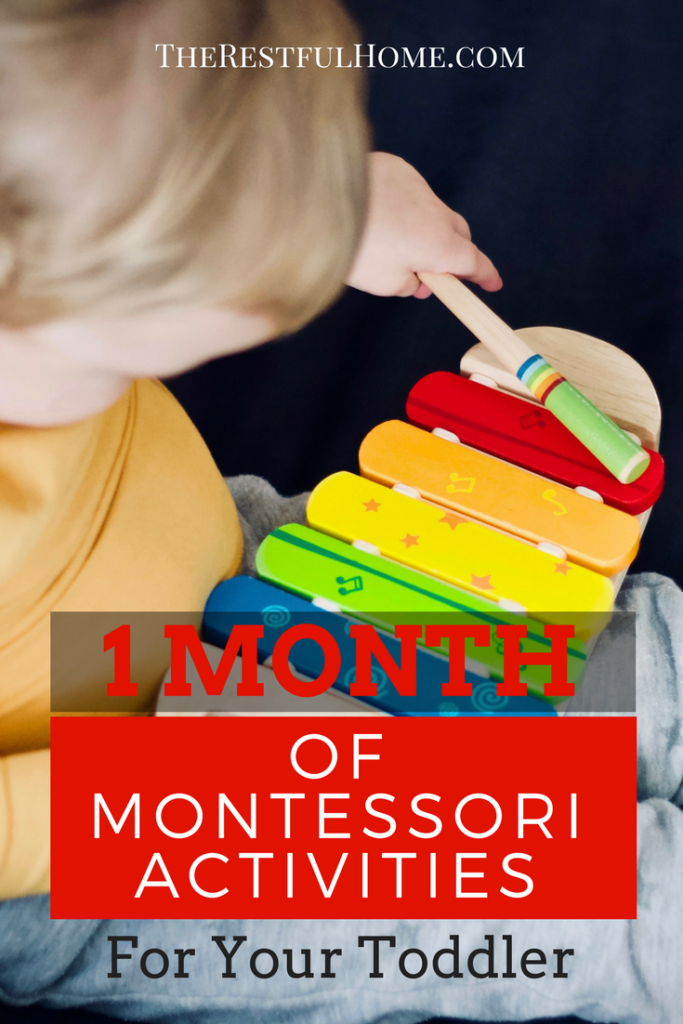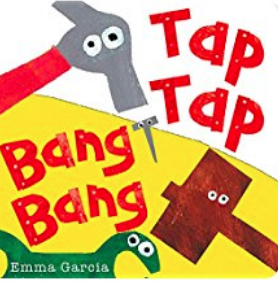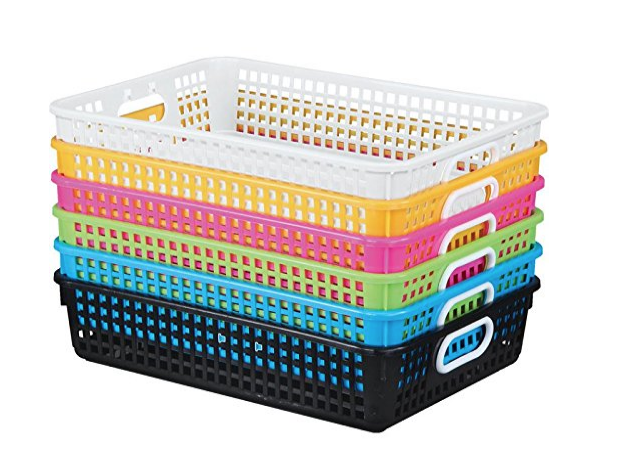 Once your baby becomes a toddler, the whole house becomes her playground. She’s opening cabinets, climbing couches, curious about everything. And you’re running out of things to do with her. Here’s one month of already-planned, Montessori-inspired activities to make your life easier! You can do variations of these Montessori activities with your 1-3 year old, whether or not you follow Montessori routines throughout your day. (At the end of the post, you’ll find a free, easy-to-print calendar with the month of activities already typed in for you! Even if you don’t get all the activities done in one month, it’s a convenient idea list to have on hand.)
Once your baby becomes a toddler, the whole house becomes her playground. She’s opening cabinets, climbing couches, curious about everything. And you’re running out of things to do with her. Here’s one month of already-planned, Montessori-inspired activities to make your life easier! You can do variations of these Montessori activities with your 1-3 year old, whether or not you follow Montessori routines throughout your day. (At the end of the post, you’ll find a free, easy-to-print calendar with the month of activities already typed in for you! Even if you don’t get all the activities done in one month, it’s a convenient idea list to have on hand.)
Curious about Montessori? Read this comparison of Montessori and Waldorf educational philosophies.
30 Days of Montessori Activities for Babies and Young Toddlers
Thank you for using our affiliate links!
Week 1: Exploring the World Through the 5 Senses
Day 1: Sensory Play Dough Day (touch)
Make edible play dough in different colors and have fun smushing and rolling (younger toddlers) or creating (older toddlers). You can add glitter (I rolled ours in old Christmas cards one day with Baby J), although that makes it less edible! You can also have a tray of beads, beans, or whatever else is on hand to push into the play dough if you’re not planning to keep it in the refrigerator for future play.
Day 2: Cooking Day (taste and smell)
Mash up a banana or a soft-cooked vegetable with your little one and let her start adding spices (after smelling them). Talk about what seasonings taste good with others. Stir up a wonderful concoction. (You will have to help her decide which items to add and how much of them, since at this age it’s a lot of fun to dump but not much fun to eat the results.) Pull out raisins, dried cranberries, and other easy ingredients to blend from your cupboards. Then have a tea party with your special snack.
Day 3: Shapes Day (touch and see)
Shape-exploring is one of my favorite “Montessori activities” to do with Baby J! We have a wonderful book with flaps in different shapes, and almost every day he asks me to read it to him and say the names of all the shapes. Look for different shapes in his toy box, create little figures in different shapes, or use a geometric solids toy to help him explore the world of new shapes.
Day 4: Rhythm Sticks and Movement Day (hear)
Music makes every day better! I found a wonderful video giving me some ideas for rhythm sticks with Baby J last week. (Here’s a link to Sarah Berry’s mini-class with babies.) You can dance with your toddler and let him tap sticks together as you play fun music with clear rhythm. (Old MacDonald Had a Farm, If You’re Happy and You Know It, etc.) You can buy special rhythm sticks that allow you to make different noises, or just use the skinny ends of wooden spoons.
Day 5: Textures Day (touch)
Libraries are great for textures day, because they often have board books for children with different-textured pages. Also, during your child’s outside time, help him or her notice all the different textures. Children are constantly rubbing and touching and stepping on anything that looks unusual to them, so really you’re just joining in the activities they do naturally and giving the textures names. “Soft! Ouch–that’s poky! Oooh…slimy.” If you have a textured puzzle at home (like this one), play with it with your child after naptime to reinforce what she’s learned about textural differences today.
Day 6: Finding Disappearing Objects Day (see)
If you have an object permanence box, this is the day to pull it out of the closet and use it! (Hiding toys for a while and then reintroducing them makes them brand-new to kids at this age!) If not, set up a shoebox or curtain and hide things from your little one so she can crawl around it/reach inside it to find the object. Play hide and seek with your toddler (unless she’s going through a stage of suffering anxiety every time you’re out of sight). Object permanence is developed a long time before this (typically between 4-7 months of age), but is still an important concept to reinforce. Using an object permanence box will help grasping skills, as well, since the child has to drop the ball into a hole.
Day 7: Gardening (see, touch, taste, smell)
If you have pots of herbs or a garden outside, take your toddler out to explore the garden and taste the herbs. If not, you can buy fresh herbs at Walmart, put them in water, and some of them (basil) will root out, forming new plants you can pot. Let your child pinch off leaves and smell and taste them.
Week 2: The World of Color
Day 8: Exploring the Color Red
Go on a walk and look for red landmarks (fire hydrants, red roofs, etc.). Take a crayon with you and compare it with the landmarks. Then come home and gather red items in your home. Have your toddler place them in a basket and examine them. Open your spice drawer, examine red-colored spices and sniff them. Talk about their scents and tastes. “Spicy!” Read a book about colors and find the red pages. (Our favorite color-book is the board book below.)
Day 9: Exploring the Color Blue
Time to add another color to your Montessori work basket collection! You can start the day out with blueberries for breakfast, talking about the color blue, and then going outside to see if the sky is blue today. Collect objects around the house that are blue, separating toys if necessary (since sometimes they will have blue components/building blocks) and put them in a basket. Show your child the red basket. Mix the two colors together and then help your toddler separate them into different baskets again. Read your color-book again and find everything that is blue. Allow your child to select other books for reading time and, as you read, point to blue pictures. (If you have an older toddler, ask him to find the blue objects on the pages without your help unless necessary. My 17-month-old, though, wouldn’t be able to point to all the blue things by himself yet.)
Day 10: Exploring the Color Yellow
Add another color to your toddler’s repertoire! Breakfast today is eggs (if your child eats hard-boiled eggs, you can help him separate white from yellow and point out the difference). Next, find items around the house that are yellow. Add them to a basket. If you’re feeling rich, head to the Dollar Tree and pick up some pom-poms and large, colorful beads to separate into your color-themed baskets.
Day 11: Exploring the Color Green
Open the crayon box in the morning and let your child color, talking with him about the different color names as he makes his work of art. When he’s using green, talk about what else we know about that’s green. You can let him look in the vegetable crisper in your refrigerator and point at the green vegetables. If he’s hungry, offer him a green snack. (Celery, snow peas, etc.) Outside time is a blast with the color green–there are always many trees and bushes he can find that have different shades of green.
If you still have green edible PlayDoh in the refrigerator, playtime could include building trees and bushes out of the Playdough.
Days 12-14: Orange, Violet (Purple), and Rainbow Days
Eat oranges and grapes, make new color baskets, have a sorting-colors day, and then celebrate rainbows on the last day of the week. You can read the story of Noah’s ark and the first rainbow during your regular reading time. Keep using your color book(s), crayons, and continue looking through the house for items in the different colors you’re exploring.
Week 3: Using Tools and Toys to Practice Motor Skills and Make Music
Day 15: Wooden Puzzle Day
You can get a wooden puzzle with large handholds in many stores. Another option for young children is blocks that stack onto posts, such as the inexpensive wooden train above.
Day 16: Fine Motor Skills Day
If your toddler is beginning to want to feed herself with a spoon, today is a great day for spoon practice! Fill a wide, shallow box with dried pinto beans or anything else in the pantry that’s easy to clean up. Set an ice tray either next to the box or nestled inside it. Let your toddler use tools to transfer the beans into the ice cube tray. These could be spoons or fun grasping tools. If she decides to use her fingers, she’s still practicing her fine mother skills because she has to carefully pinch and carry the little beans.
 Day 17: Let’s Play Ball (gross motor skills)
Day 17: Let’s Play Ball (gross motor skills)
Choose an oversized ball, such as a soft, mesh-covered beach ball. Practice rolling on top of it, pushing it, and throwing it. If your child is older, have her try standing on one foot and throwing the ball. Encourage her to think of other “tricky” ways she can play with the ball. If your child is still in the transitional stage between baby and toddler, he can crawl along while pushing the ball. Help him roll over the top of the ball with his body, especially if the ball is smaller than he is. Try to help him gain independence as he plays ball.
Day 18: Music Time!
Create a playlist for your child of happy music. (I like to play Spanish music for J.) Use a set of bells/a child’s xylophone OR set up different sizes of metal bowls for tapping, and play along with the music during one song. Your child will probably be anxiously awaiting her turn, but have her watch for at least the first verse/chorus. Then let her take charge of the “instrument.”
Day 19: Lacing/Sewing Day
You can make your own lacing toy by knotting string, pulling it through a paper plate, and making plenty of holes. Make sure your lacing tool is small enough to go through the holes but not too small for your toddler’s fingers. Or, you can buy a lacing toy. (Link to an example below.)
Day 20: Construction Worker
Make your little one into a construction worker for the day! Make a hat out of construction paper 
Day 21: Make an Instrument Day
Choose an instrument to make for/with your child. (Here’s the list of homemade instruments you can easily put together.) Model playing along with music on the radio and then let her play to her heart’s content. If you play a real instrument, try playing it and letting her accompany you.
Week 4: The World Outside
Day 22: Sticks and Stones
Go outside and explore nonliving things–dead sticks, stones, etc. This would be a great day for throwing rocks in the pond/river if you live near one! You can bring music into this day by using your rhythm sticks to make music, or by collecting small pea gravel in a container to make a shaker.
Day 23: Leaves and Flowers
Let your child explore plants today. If you have a vegetable garden, let her help you harvest today’s meal, tear up herbs for spices, etc. If not, go to a nursery and let your child smell the flowers and maybe choose a plant to take home. For older toddlers, you can try activities like sprouting beans in a wet paper towel, but for babies/young toddlers, such extended-time activities won’t make much sense.
Day 24: Things that Go
Today is the day to wave at cars, play with trucks and trains in the playroom/bedroom, and read stories about things with wheels. You can visit a toy store and look at different types of vehicles there, go to the library and check out books on things that go (look for books for tomorrow’s activity, as well), or even stop near a train station and watch a train go by, imitating the noises.
Day 25: Funny Noises
Animal noises, car noises, plane noises–and funny noises! Make this a fun storytime day. (Suggested reading: Mr. Brown Can Moo! Can You?)
Day 26: Painting the Sidewalk with Water (or Chalk)
If you have a sidewalk or carport entrance, have fun next to your child drawing pictures on it with sidewalk chalk. Don’t want the mess of chalk? Just use paintbrushes your child can dip into water. She can use wet brushstrokes to paint happily on the cement.
Day 27: Digging Day
If you don’t have a sandbox, look for a nearby park that has one or something similar where children can dig. Help your toddler outline a garden and use twigs and leaves for imaginary plants. Or, you can bury “treasures” in the sandbox for your child to dig up. (This might be a day to bring out the book Pirates Don’t Change Diapers! When I worked as a children’s librarian, that book was always a favorite for children ages 3-5!)
Day 28: Look at all the Buildings
Go downtown (or outside if you live in a large apartment complex/near city buildings). Point at tall buildings, short buildings, shiny buildings, and old buildings. Ask your toddler questions, even if he isn’t speaking much yet. Have a storytime about houses and buildings. Use blocks to help your toddler build his own buildings.
Day 29: Review Colors
Read your color books again. Get out the baskets you’ve made for all your colors, point out the different colors, and have a sorting time. If your child enjoys coloring/painting, have picture-making time.
Day 30: Finger-Painting Day!
Climb in the bathtub and start painting with sloppy, paint-covered hands. You can easily clean the bathtub–and your messy child–when the fun comes to an end.
Download and Get Started with the Fun!
For an easy-to-read version of these Montessori activities, please download this free printable calendar: Montessori Activities for Your Toddler. (PDF)
If you’re concerned that you aren’t doing enough for your child’s development, read these five things you’re already doing to help his/her mind develop and be encouraged! You’re doing a great job!











 : a favorite place to walk when we can!
Once
: a favorite place to walk when we can!
Once 
![The first photos are of my parents’ sprawling rural Arkansas garden. The last is of my tiny little beds in the big city. Plants bring life to even the smallest corner!
I’ve been reading some beautiful fiction this year, and I just posted a review of a book by one of my favorite authors, Leif Enger. (https://therestfulhome.com/brave-young-handsome-review/ in your browser, or click on the link in my Instagram profile) If you don’t have time to read the book, though, here’s just a quote or two for your enjoyment:
🎼
“Death arrived easy as the train; [he] just climbed aboard, like the capable traveler he was.”
🛤️
On riding a horse: “You are a feeble and tenuous being; the only thing a horse wants from you is your absence.” 🐎 😄
#quotes #leifenger #amreading #gardens #gardening](https://scontent-atl3-1.cdninstagram.com/v/t39.30808-6/468657020_18342474787176025_4442629541396867851_n.jpg?_nc_cat=108&ccb=1-7&_nc_sid=18de74&_nc_ohc=DEja6UP2ct4Q7kNvgEYJxCM&_nc_zt=23&_nc_ht=scontent-atl3-1.cdninstagram.com&edm=ANo9K5cEAAAA&_nc_gid=AA4bBsvQ_JpqZXLUPUTpTC8&oh=00_AYCjI9LUx-cJxe6cu0n7H1Gounaz92aBlTrQacnKut8umg&oe=67567CAB)
















